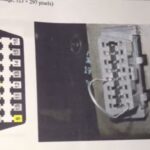Diagnostic Trouble Codes, often referred to as OBD2 trouble codes, are the standardized language your car’s onboard diagnostic system uses to communicate potential issues. When your vehicle detects a problem outside of normal operating parameters, it triggers a trouble code, storing it in its memory and often illuminating the check engine light. These codes are crucial for identifying and rectifying malfunctions, ensuring your vehicle runs smoothly and efficiently.
Each OBD2 trouble code is composed of five characters: a letter followed by four digits, for example, P0123. Understanding the structure of these codes, particularly Global Obd2 Codes, is the first step in effective car diagnostics.
Understanding the Format of Global OBD2 Codes
OBD2 trouble codes are categorized to pinpoint the area of the vehicle experiencing the problem. The very first letter of the code indicates the system affected:
- B-codes (Body): These codes relate to components typically found within the passenger compartment, dealing with convenience, comfort, and safety features.
- C-codes (Chassis): Chassis codes pertain to systems generally located outside the passenger compartment, including mechanical systems like steering, brakes, and suspension.
- P-codes (Powertrain): Powertrain codes are the most common, covering issues within the engine, transmission, and related drivetrain components.
- U-codes (Network & Vehicle Integration): These codes indicate problems in the communication network and integration between the vehicle’s various computer systems.
The first digit following the letter is critical in determining if you are dealing with a global OBD2 code or a manufacturer-specific code.
Global OBD2 codes, also known as generic codes, are identified by a ‘0’ as the first digit after the letter. For example, P0XXX, C0XXX, B0XXX, and U0XXX codes are all classified as global. These are standardized codes recognized across all OBD2 compliant vehicles, regardless of make or model. The standardization of global OBD2 codes is incredibly beneficial, as it provides a common diagnostic foundation for a wide range of vehicles. This means a P0300 code, indicating a random misfire, will have the same general meaning whether it’s retrieved from a Ford, Toyota, or BMW.
In contrast, codes beginning with ‘1’ (e.g., P1XXX) are manufacturer-specific or enhanced codes. These codes are unique to a particular automaker and often delve into more detailed or proprietary issues not covered by the global OBD2 code set. While global OBD2 codes address common problems, manufacturer-specific codes help dealerships and specialized mechanics diagnose more intricate issues.
Digits ‘2’ and ‘3’ in this position are less common for the first digit after the letter and their meaning can vary depending on the system. For instance, P2xxx codes are generally generic, while P3xxx powertrain codes are manufacturer-controlled. Similarly, B2xxx and C2xxx are manufacturer-controlled body and chassis codes, whereas B3xxx and C3xxx are currently reserved. U2xxx and U3xxx codes within the network and vehicle integration category are also manufacturer-specific.
The subsequent digits, the last three in most cases, provide a more granular description of the specific fault. These final digits pinpoint the exact nature of the problem. Unfortunately, there isn’t a universal formula to automatically decipher these last digits; each combination is individually defined.
Fortunately, resources like OBD Auto Doctor software compile extensive databases of fault code descriptions, covering tens of thousands of diagnostic trouble codes, including all global OBD2 codes.
Why Focus on Global OBD2 Codes?
For car owners and DIY enthusiasts, understanding global OBD2 codes is an invaluable starting point for vehicle diagnostics. When your check engine light illuminates, reading the global OBD2 code is often the first step to understanding the potential issue. Because they are standardized, global OBD2 codes provide a consistent and reliable initial diagnosis across different makes and models. This allows you to:
- Quickly identify the general area of the problem: Is it engine-related (P-code), chassis (C-code), body (B-code), or network (U-code)?
- Gain a basic understanding of the fault: While the code itself is numeric, code readers and software translate these codes into understandable descriptions, giving you a starting point for investigation.
- Communicate effectively with mechanics: Knowing the global OBD2 code allows you to discuss the issue more knowledgeably with a repair shop, potentially saving time and ensuring clearer communication.
While manufacturer-specific codes offer deeper insights, global OBD2 codes are the foundation of OBD2 diagnostics. They are the universally understood language that helps everyone from car owners to professional technicians begin the process of identifying and resolving vehicle issues.
To learn more about the specific meaning of a global OBD2 code triggered by your vehicle, using an OBD2 scanner and diagnostic software is recommended. This will provide you with the fault description and guide you towards effective troubleshooting and repair.
